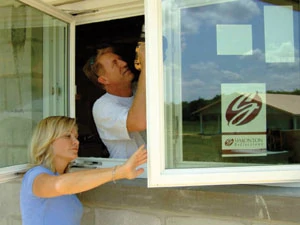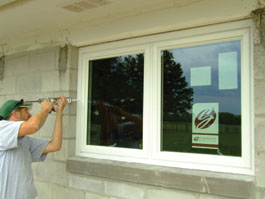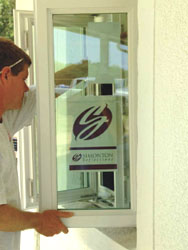When it came time to replace the old single-paned, metal-framed windows in her home near Ocala National Forest in Florida, Dr. Anna Marie, health specialist for The Weather Channel, researched energy-efficient glass options.
“The added incentive of the government’s tax credit for replacing old windows with highly energy-efficient windows made me focus on the windows as a priority in the renovation,” says Dr. Anna Marie, host of the nationally-syndicated “Your Life with Dr. Anna Marie” television show.
“We’re transforming an old home into an eco-friendly, energy-efficient and healthy home. The windows play a major role in this endeavor. As soon as the Simonton vinyl windows were installed I noticed a dramatic change.
“The sound reduction from the exterior into the home was amazing. And, even under construction with holes in the house everywhere, there was a noticeable drop in the interior temperature during the heat of the day. The energy efficiency features started working the minute these windows were installed.”
Saving Energy
Thanks to the American Recovery and Reinvestment Act of 2009, when taxpayers purchase replacement windows that meet specific energy efficiency requirements, they are eligible for up to 30 percent of the amount of the windows purchased, returned as a tax credit.
The law has some very specific restrictions that all homeowners should understand. These include:
1. Windows purchased must be equal to or below a U-factor of 0.30 and a Solar Heat Gain Coefficient (SHGC) of 0.30.
2. The purchase of the qualified windows must be made during the taxable year for which the credit is being claimed.
3. The credit is only allowed on the price of the qualified windows themselves, not on installation costs, on-site preparation, assembly or sales tax.
4. The tax credit is allowable only for qualified window units placed in service in 2009 and 2010.
What exactly is a tax credit? Unlike a tax deduction that only reduces the amount of your taxable income, a tax credit reduces the amount of tax you owe to the government.
Understanding 0.30/0.30
One of the key aspects of gaining this tax credit is the 0.30/0.30 requirement, which is more stringent than Energy Star qualifications for windows in many geographic areas. For that reason, it’s important to understand the energy-efficient aspects of a window.
The U-factor for a window relates to the amount of heat transferred through a material. Basically, how much sunlight can penetrate your glass and enter the home. The lower the U-factor, the slower the rate of heat flow and the better the insulating quality of the window.
The Solar Heat Gain Coefficient (commonly referred to as the SHGC) represents the percentage of heat gained from both direct sunlight and absorbed heat. The smaller the number, the greater the ability to reduce solar heat gain into the home.
“By having an SHGC of 0.30 or lower, a replacement window is helping your home remain comfortable inside, regardless of the outside temperature,” says Christopher Burk with Simonton Windows. “This, combined with a U-factor, reduces the amount of energy required to warm and cool your home during different seasons.
“The government is offering homeowners this incentive to make homes more energy-efficient. That’s great news for all of us because energy-efficient replacement windows immediately help reduce energy bills from the day they are installed. And, these same windows add to the beauty and curb appeal of the home. When selecting vinyl replacement windows, homeowners also gain a low maintenance product that makes life easier.”
Energy Tax Credit Glass Packages
To make identifying a qualifying window package easier for homeowners and remodelers, some window manufacturers have developed special product lines and web sites. One example is the Simonton Windows Energy Tax Credit (ETC) glass packages. Every window specified with these glass packages is guaranteed to be eligible for the tax credit.
Since homeowners in different geographical areas (such as coastal areas versus mountain regions) may wish to have different levels of qualifying glass packages, Simonton offers the following:
• The ETC Starter glass package includes a 3/4-inch IGU, Intercept® Spacer System, Argon gas fill and ProSolar™ Soft Coat Low E glass.
• The ETC Starter 366 glass package includes a 3/4-inch IGU, Intercept® Spacer System, Argon gas fill and LoE3-366® glass.
• The ETC Super Solar glass package includes a 7/8-inch IGU, Super Spacer® System, Argon gas fill and ProSolar™ Soft Coat Low E glass.
• The ETC Super 366 glass package includes a 7/8-inch IGU, Super Spacer System, Argon gas fill and LoE3-366 glass.
• The ETC Super Solar SBP glass package for StormBreaker Plus® windows includes a one-inch IGU, Super Spacer® System, Argon gas fill and Low E glass on one surface with impact-resistant glass.
• The ETC Super 366 SBP glass package for StormBreaker Plus® windows includes a one-inch IGU, Super Spacer System, Argon gas fill and LoE3-366 glass on one surface with impact-resistant glass.
What to Know
Once a homeowner has purchased the windows, it’s important to save the receipt for the window purchase for tax purposes. The cost of the windows themselves should be shown separately from the installation costs on the invoice. In addition, homeowners should save all the window labels that come with every window, especially the National Fenestration Rating Council (NFRC) label. Homeowners should also request a manufacturer’s certification statement to authenticate that the window(s) purchased meet the qualifications for the tax credit.
People purchasing qualified windows in 2009 can submit to receive a tax credit on their 2009 taxes. Those purchasing qualified windows in 2010 can submit to receive the tax credit on their 2010 taxes.
One Family’s Story
In Sugar Land, Texas, the Jones family discovered the value of energy savings first-hand this past summer. The winners of the “Energy Savings Makeover” project organized by Houston KSEV radio show host Gary Parr, the family was chosen to receive a new HVAC system, tankless water heater, programmable thermostat, insulation, solar attic fans and other energy-efficient features. One of the largest benefits of the makeover was gaining new ETC glass package replacement windows.
“We selected this home because it represented a typical Houston area house that could truly benefit from an energy savings makeover,” says Parr. “This family of six used to spend more than $900 a month on energy bills during the summer. That’s because the home had little insulation, an inefficient HVAC system and old, single-paned aluminum-framed windows. Some of the windows were blocked to keep the sun’s powerful rays from baking the interior of the home. Other windows were inoperable, so the home didn’t have enough ventilation.”
The Jones’s 2,800-square foot, two-story home was built in the late 1970’s. The original windows had clear glass with no energy-efficiency benefits, so that the family’s air conditioning system worked continually to cool the home. To rectify the problem, the 20 old windows were replaced with Simonton’s ETC glass package replacement windows.
“Poorly-insulated windows can result in hefty energy bills, faded carpets and furnishings, and an uncomfortable living environment,” says Parr. “With the energy-efficient Simonton windows we installed in this home, we saw an immediate savings on the energy bills and a distinct improvement in the living quality of the home. This is the kind of home improvement project that homeowners nationwide can do to save on immediate energy bills and on the tax credit from the government.”





